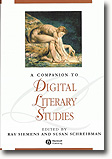| 2007 |
“Imagining the New Media Encounter” (Introduction to A Companion to Digital Literary Studies)Categories Essays , Publications Essays , Publications
|
 Citation: “Imagining the New Media Encounter.” A Companion to Digital Literary Studies. Ed. Ray Siemens and Susan Schreibman. Malden, MA: Blackwell, 2007. 3-25
Citation: “Imagining the New Media Encounter.” A Companion to Digital Literary Studies. Ed. Ray Siemens and Susan Schreibman. Malden, MA: Blackwell, 2007. 3-25
No new media experience is fully imaginable, it appears, without the help of what may loosely be called narratives of new media encounter such as this Caliban moment of media enchantment/media colonization in McLuhan’s essay. Whether told from the perspective of the native of old media or the ambassador of new media, such tales are a staple of epochs undergoing media change. Two other paradigmatic examples are Plato’s myth in the Phaedrus of the inventor of writing giving his demo and Claude Lévi-Strauss’s account in Tristes Tropiques of the tribal chief who imitated the anthropologist’s writing:
One might also think of such similar cross-historical pairings as Augustine’s account of coming upon Ambrose engaged in the new practice of silent reading (“when we came to see him, we found him reading like this in silence, for he never read aloud” [VI.3]) and W. J. T. Mitchell’s pedagogical exemplum of “showing seeing” (a simulation of new media contact in which “I ask the students to frame their presentations by assuming that they are ethnographers who come from, and are reporting back to, a society that has no concept of visual culture. . . . Visual culture is thus made to seem strange, exotic, and in need of explanation” [Mitchell 1998: 97]).
Many more instances could be cited; and, indeed, narratives of new media encounter in the form of first contact with the Word, Book, Law, Image, Music, and (more recently) Code are deeply embedded in the entire historiography of Early Modern religious or imperial conquest, Enlightenment and industrial “modernization,” twentieth-century “control through communication” (coupled with “mass entertainment”), and postindustrial “informating” or “knowledge work.” While narratives of new media encounter are modernization narratives, alternative visions of modernity and its complex identities emerge. The weaker form of this thesis may be put this way: new media encounters are messy. . . (p. 9)It might be hypothesized that all major changes in the socio-cultural order are channeled symbolically and/or instrumentally through narratives of media change–to the point, indeed, that such narratives often take on the significance of conversion experiences. New media encounters are a proxy wrestle for the soul of the person and the civilization. Augustine’s conversion (“take it and read,” the children sing over the garden wall in one of history’s most potent stagings of random-access reading [VIII.12] is not unique). Dramatizations of the instant when individuals, villages, or nations first wrap their minds around a manuscript, book, telephone, radio, TV, computer, cell phone, iPod, etc., are overdetermined. McLuhan spoke of “electric media” as if it were the incandescent star of a new nativity. And adepts of digital media today reverence the “born digital” with something of the conviction of the “born again.”
Or, more accurately, “conversion” connotes too right-angled a change. The better term is indeed “encounter,” indicating a thick, unpredictable zone of contact–more borderland than border line–where (mis)understandings of new media are negotiated along twisting, partial, and contradictory vectors. But there is also a strong version of this thesis that will provide an appropriately dramatic finish to this synopsis of the new media encounter: narratives of new media encounter are reversible. (p. 10)To adapt Jean-François Lyotard’s concept, we may say that media contact zones are like the pagus in classical times: the tricky frontier around a town where one deals warily with strangers because even the lowliest beggar may turn out to be a god, or vice versa. New media are always pagan media: strange, rough, and guileful; either messengers of the gods or spam. Narratives of new media are thus less objective accounts than speculative bargaining positions. Encountering a new medium, one says in essence: “what do I get if I deal with this as if it were really a scroll, book, TV, phone, radio, or surveillance instrument (and so on) in disguise?” In addition, since any speculation has its risk-averse side, narratives of new media encounter are also in part conservative. Like photographic vignettes in the nineteenth century, they have rounded, gradient contours that blur the raw edge of new media into the comfort zone of existing techno-social constraints, expectations, and perceptions.
At once descriptive and interpretive, speculative and wary, proselytizing and critical, and visionary and regulatory, narratives of new media encounter are the elementary form of media theory–the place from which all meta-discourse about media starts. Or again, they are intra-discursive: part of the self-mediating discourse or feedback by which media “ecologies,” as they have recently been called, adapt systemically when new forces swarm across the border.
